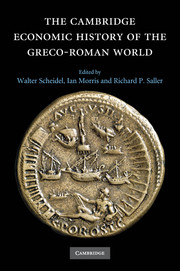Book contents
- Frontmatter
- 1 Introduction
- Part I Determinants of Economic Performance
- Part II Early Mediterranean Economies and the Near East
- Part III Classical Greece
- Part IV The Hellenistic States
- 15 The Hellenistic Near East
- 16 Hellenistic Egypt
- 17 Hellenistic Greece and Western Asia Minor
- Part V Early Italy and the Roman Republic
- Part VI The Early Roman Empire
- Part VII Regional Development in the Roman Empire
- Part VIII Epilogue
- Bibliography
- Index
- Map 1.1 The Mediterranean basin"
- Map 10.1 Greek and Phoenician trade in the period of the Persian Wars"
- Map 11.1 The Achaemenid empire"
- Map 12.1 Greece and Asia Minor"
- Map 15.1 The Seleucid empire"
- Map 16.1 Greco-Roman Egypt"
- Map 20.1 The Roman empire at the accession of Vespasian"
- References
15 - The Hellenistic Near East
from Part IV - The Hellenistic States
Published online by Cambridge University Press: 28 March 2008
- Frontmatter
- 1 Introduction
- Part I Determinants of Economic Performance
- Part II Early Mediterranean Economies and the Near East
- Part III Classical Greece
- Part IV The Hellenistic States
- 15 The Hellenistic Near East
- 16 Hellenistic Egypt
- 17 Hellenistic Greece and Western Asia Minor
- Part V Early Italy and the Roman Republic
- Part VI The Early Roman Empire
- Part VII Regional Development in the Roman Empire
- Part VIII Epilogue
- Bibliography
- Index
- Map 1.1 The Mediterranean basin"
- Map 10.1 Greek and Phoenician trade in the period of the Persian Wars"
- Map 11.1 The Achaemenid empire"
- Map 12.1 Greece and Asia Minor"
- Map 15.1 The Seleucid empire"
- Map 16.1 Greco-Roman Egypt"
- Map 20.1 The Roman empire at the accession of Vespasian"
- References
Summary
introduction
Between 334 and 323 bc Alexander the Great conquered an empire stretching from Macedonia and Egypt to the Indus. Alexander died young without heirs, but Macedonian dynasties dominated the Near East for two or three centuries, encouraging Greek and Macedonian immigration and founding new cities with Greek citizens and political institutions. After Alexander’s death his feeble-minded brother Philip III and posthumously born son Alexander IV maintained the fiction of kingship (323–317 and 317–?310, respectively), while his generals (particularly Antigonus the One-eyed, strategos of Asia; Seleucus, satrap [governor] of Babylonia; Lysimachus, satrap of Thrace; and Ptolemy, satrap of Egypt) warred over his empire.
The two kings were murdered and three new states emerged. The Seleucid empire occupied the greater part of Asia (hence the empire is often called Asia in contemporary sources), from Turkey to Afghanistan. Ptolemy founded the Ptolemaic empire in Egypt and Syria-Palestine. Descendants of Antigonus came to rule Macedonia, with political hegemony over Greece. All these states succumbed to Rome: Macedonia in 148 bc, the Seleucids in 64 bc, and Egypt in 30 bc. The imperial boundaries were never stable, and war was almost continuous. Smaller new kingdoms emerged, like the Attalid state of Pergamum on the west coast of Asia Minor in the second half of the third century and the Jewish kingdom of the Maccabees around 150. Antiochus III conquered Syria-Palestine from the Ptolemies in 200 bc, but lost Asia Minor to Pergamum and Rhodes after being defeated by Rome in 189 bc. Antiochus IV invaded Egypt in 169 and 168, the Romans forced him to retreat.
Keywords
- Type
- Chapter
- Information
- The Cambridge Economic History of the Greco-Roman World , pp. 407 - 433Publisher: Cambridge University PressPrint publication year: 2007
References
- 9
- Cited by

